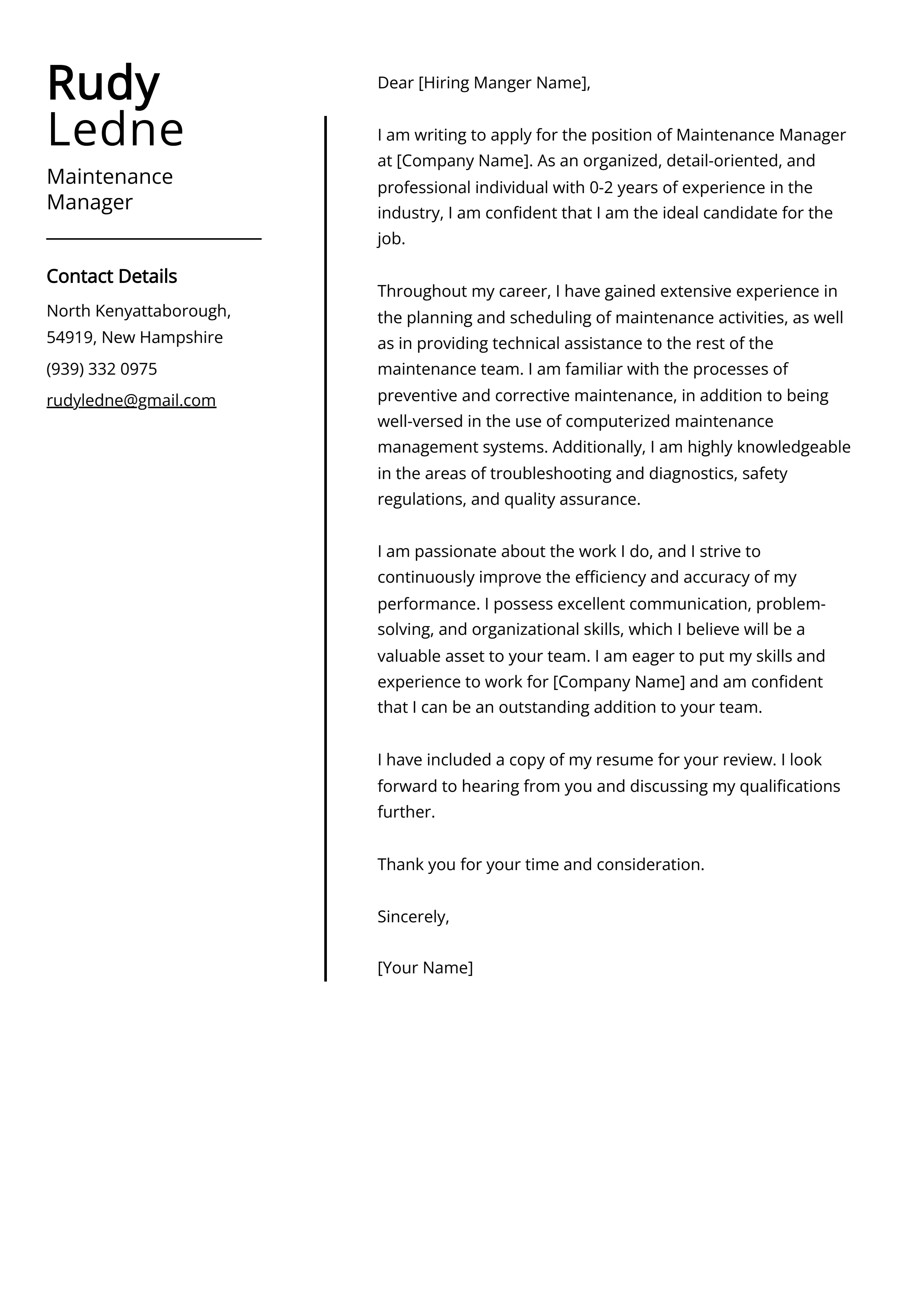What is a Maintenance Cover Letter (Overview)
A maintenance cover letter is a crucial document that accompanies your resume when applying for a maintenance-related job. It serves as your introduction to the hiring manager, providing an opportunity to showcase your skills, experience, and enthusiasm for the position. Unlike a resume, which provides a factual overview of your qualifications, a cover letter allows you to personalize your application, explain your career goals, and highlight how your abilities align with the specific requirements of the job. It’s a chance to make a strong first impression and persuade the employer to invite you for an interview. A well-written cover letter can significantly increase your chances of landing your dream job in the maintenance field. It goes beyond just listing your qualifications, it shows your personality, and your desire to work for a company.
Purpose of a Maintenance Cover Letter
The primary purpose of a maintenance cover letter is to convince the employer that you are the best candidate for the job. It should articulate why you are interested in the position, what you can bring to the table, and how your skills and experience meet the needs of the company. A good cover letter helps you stand out from other applicants by demonstrating your unique value proposition. It shows that you’ve taken the time to understand the company’s needs and tailor your application accordingly. By expressing your enthusiasm and highlighting your relevant qualifications, you increase your chances of getting your resume noticed and securing an interview. Furthermore, the cover letter offers an opportunity to explain any gaps in your employment history or to address any concerns the employer might have. It is not simply a repetition of your resume, it’s a narrative that paints a picture of you as a strong candidate, explaining why they should bring you into their company.
Key Components to Include
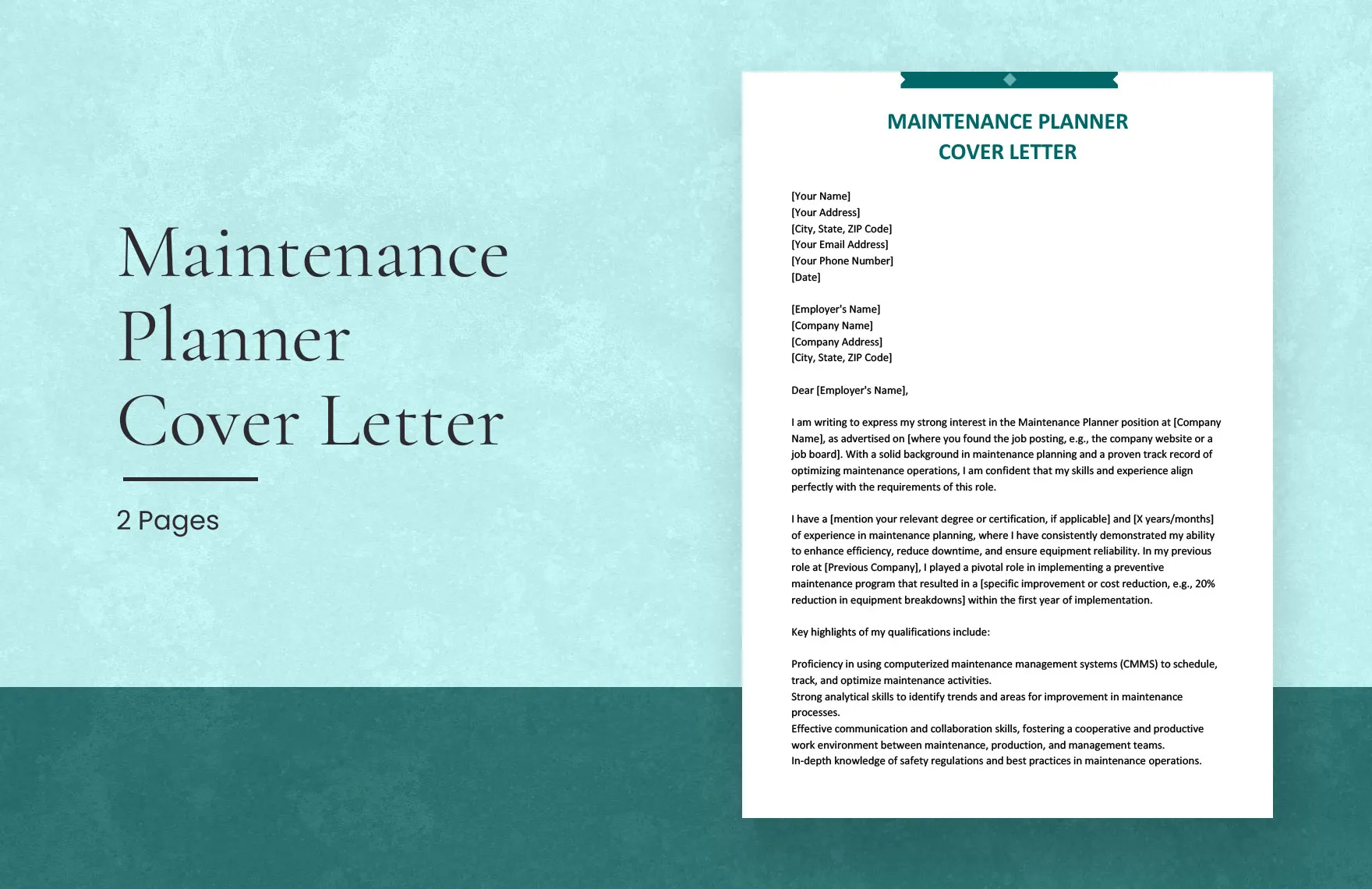
A successful maintenance cover letter typically includes several key components that work together to create a compelling narrative. These components provide structure and ensure that you communicate all the necessary information effectively. Begin with your contact information, followed by the hiring manager’s details and a professional greeting. The body of the letter should highlight your relevant skills and experience, using specific examples and quantifiable achievements to demonstrate your capabilities. Tailor your letter to the specific job requirements, emphasizing the skills and experiences most relevant to the position. Close the letter with a strong expression of enthusiasm and a clear call to action, such as requesting an interview. Finally, always proofread and edit your letter carefully to ensure it is free of errors and reflects your professionalism. Properly formatting your letter will make it easier to read and provide a better chance of being considered.
Contact Information
Start your cover letter by including your contact information at the top. This should include your full name, address, phone number, and email address. Ensure that your email address is professional and easy to read. This information allows the hiring manager to quickly contact you if they are interested in your application. Keep the formatting clear and concise. Double-check all the details for accuracy, as a simple error could prevent the employer from reaching you. Position your contact details in the top left or right corner, and make sure it stands out without being overwhelming. This ensures the recruiter can easily find your contact details if they want to reach out to you.
Hiring Manager’s Information
If possible, address your cover letter to a specific person. Research the hiring manager’s name and title and include it in the letter. Addressing the letter to a specific person shows that you’ve taken the time to research the company and are genuinely interested in the position. If you cannot find the hiring manager’s name, use a generic greeting such as “Dear Hiring Manager.” Use professional titles such as “Mr.” or “Ms.” followed by their last name. This level of personalization indicates that you are attentive to detail. Always double-check the spelling of the hiring manager’s name to avoid any embarrassing mistakes. This simple step can make a positive impression on the recruiter.
Greeting the Hiring Manager
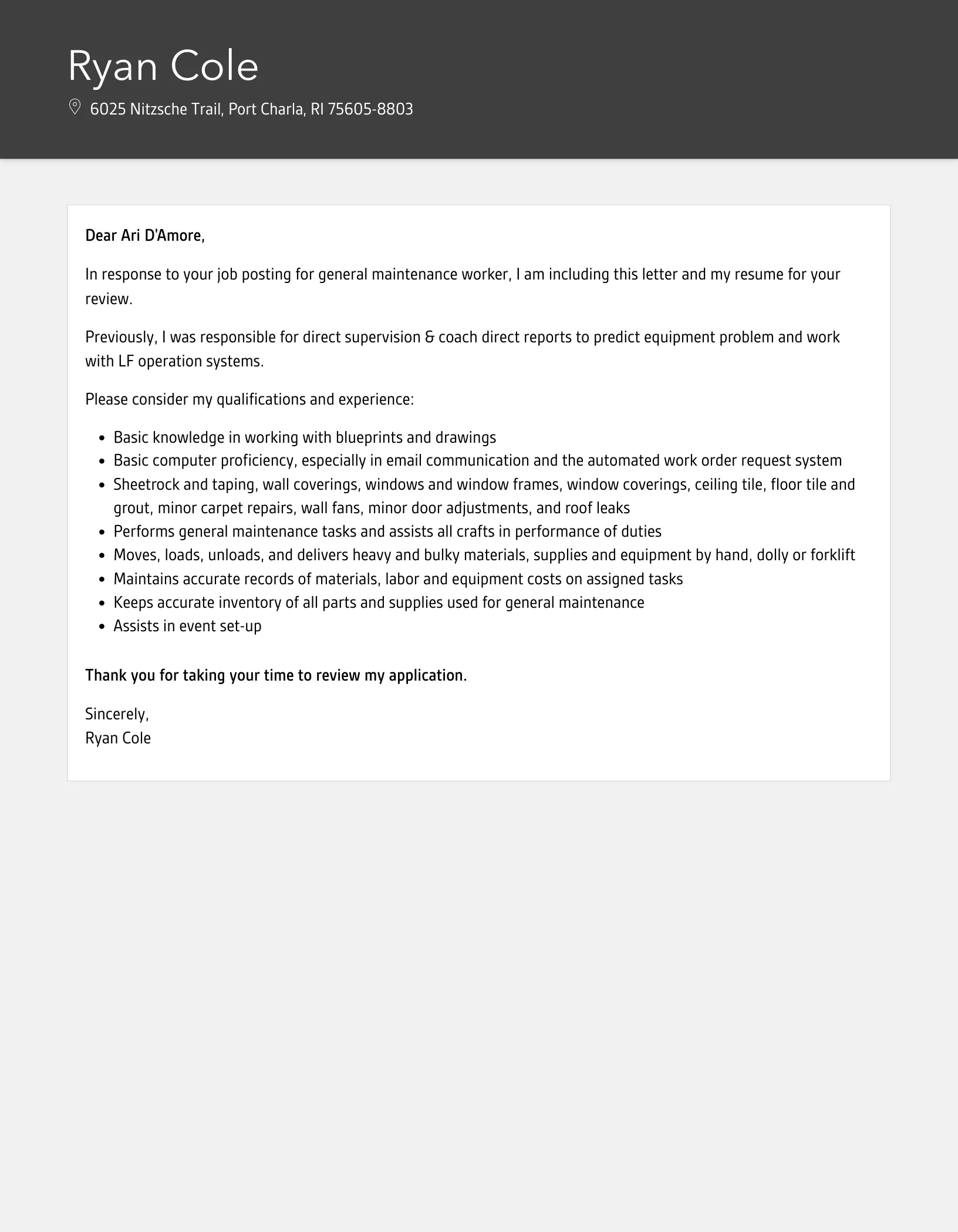
Begin your cover letter with a professional and engaging greeting. The standard greeting is “Dear Mr./Ms. [Last Name].” If you don’t know the hiring manager’s name, use “Dear Hiring Manager.” Avoid generic greetings like “To Whom It May Concern,” as these lack personalization. Your greeting sets the tone for the entire letter. It should be formal and respectful. A strong greeting shows that you are serious about the opportunity. Make sure you spell the hiring manager’s name correctly. It’s the first step in making a positive impression. Using a personalized greeting is a sign of respect that will show your professionalism.
Highlight Your Skills and Experience
The body of your cover letter is where you showcase your skills and experience. Focus on the qualifications that are most relevant to the job. Provide specific examples of your accomplishments, and use the job description as a guide to determine what skills and experiences to highlight. Describe how your skills align with the company’s needs and what value you can bring to the role. Quantify your achievements whenever possible. Use numbers and data to demonstrate your impact. Keep the language clear and concise, avoiding jargon that the hiring manager may not understand. Emphasize the results of your actions, demonstrating your ability to solve problems and contribute to the team. This section is the core of your letter, so make sure to focus on your most relevant qualities.
Relevant Skills to Showcase
Identify the key skills required for the maintenance position and emphasize those in your cover letter. Common skills to highlight include troubleshooting, repairing, and maintaining equipment, as well as experience with electrical, plumbing, and mechanical systems. Other important skills are the ability to read blueprints, follow safety protocols, and work both independently and as part of a team. Always tailor your skills to match the job description. If the job emphasizes a specific skill, such as HVAC maintenance, be sure to highlight your experience in that area. Highlight your ability to diagnose problems and find effective solutions. Showing a range of your skills helps you stand out from other applicants. The more skills you can list, the more attractive you will be to the hiring manager.
Quantifiable Achievements
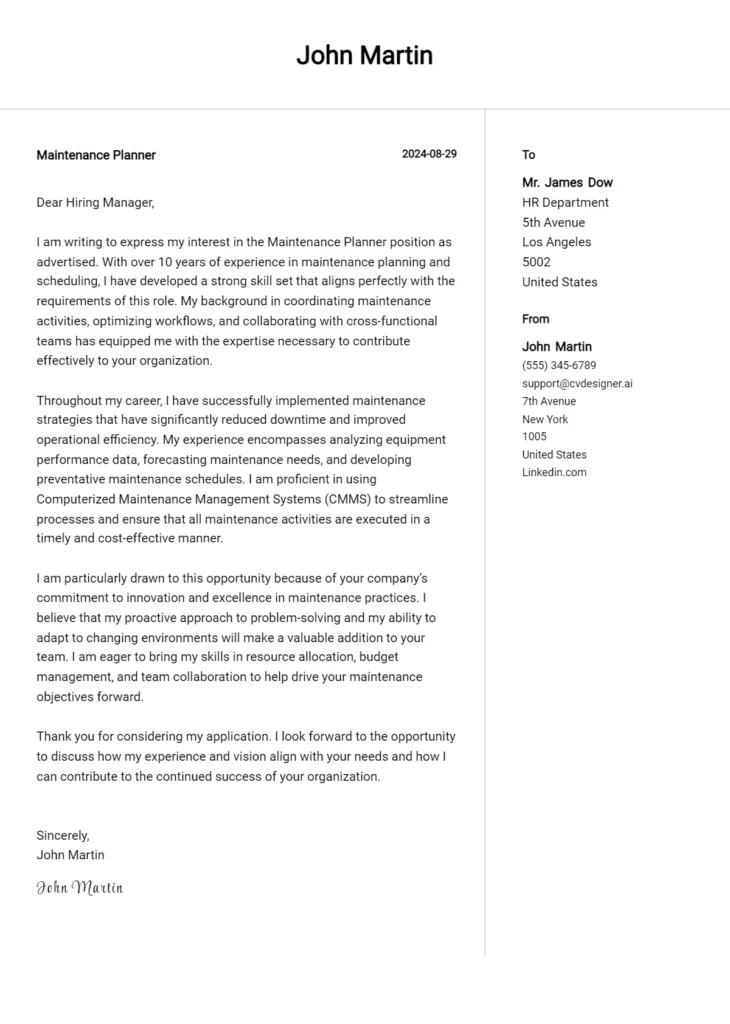
Use quantifiable achievements to demonstrate the impact of your skills and experience. Instead of saying you are good at fixing equipment, provide specific examples such as “Reduced equipment downtime by 15%” or “Completed over 100 maintenance repairs within the last year.” Use numbers to support your claims. Show how you have saved the company time or money, improved efficiency, or enhanced safety. When listing achievements, use the STAR method (Situation, Task, Action, Result) to provide a clear context. Quantifiable achievements add credibility to your cover letter, demonstrating your ability to deliver results. Focus on what you accomplished and the positive impact it had on previous employers. This type of clear demonstration can show the recruiter that you are a valuable asset.
Tailoring Your Letter
Tailoring your cover letter to each job application is essential to make a strong impression. Generic cover letters are easy to spot, and they often fail to highlight the specific qualifications the employer is seeking. Carefully review the job description, and identify the key requirements and skills. Adjust your cover letter to emphasize those requirements, demonstrating that you have the necessary experience and qualifications. Use the same keywords and phrases from the job description. This helps your letter to get noticed by applicant tracking systems (ATS) and ensures that you are addressing the employer’s needs. Tailoring demonstrates your genuine interest in the specific role. It shows you’ve taken the time to understand the company’s needs and tailor your application accordingly. This attention to detail will show you care and have a better chance of being hired.
Matching Skills to Job Requirements
Carefully compare your skills and experience with the job requirements. The job description is the key to tailoring your letter. Identify the core skills and qualifications that the employer is seeking and highlight those in your cover letter. Use specific examples from your previous work experience to demonstrate how you have used those skills. If the job requires experience with a specific type of equipment or system, be sure to emphasize your relevant expertise. Show how your experience aligns with what the employer is looking for. Tailor your examples to fit the job description. This will give the impression you have the right skills and qualifications, making you a better candidate.
Keywords to Integrate
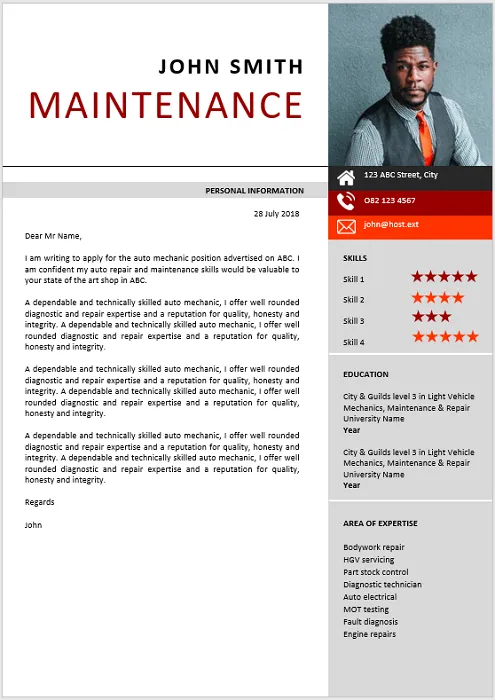
Integrate keywords from the job description into your cover letter. Applicant tracking systems (ATS) often scan cover letters and resumes for specific keywords. Use the same terms that the employer uses. This will help your application to get noticed. Don’t just stuff your cover letter with keywords, use them naturally within the context of your sentences. Incorporate keywords into your skills and experience descriptions. This ensures that the ATS recognizes your qualifications. By strategically using keywords, you increase your chances of getting your application reviewed by a human. Keyword optimization is an important part of any cover letter because it can greatly increase your chances of the hiring manager reading it.
Formatting and Tone
Formatting and tone are important elements of an effective maintenance cover letter. Proper formatting makes your letter easy to read and visually appealing. The tone should be professional, enthusiastic, and tailored to the specific job and company. A well-formatted and tone-appropriate cover letter will make a positive impression on the hiring manager, increasing your chances of getting an interview. Make sure your letter is easy to read. A letter that is too long or difficult to read will make the recruiter lose interest. Always keep in mind your audience.
Professional Formatting Tips
Use a clean and professional font, such as Times New Roman, Arial, or Calibri. Ensure that your font size is between 10 and 12 points, making it easy to read. Use standard one-inch margins on all sides. This provides a balanced look and keeps the text from appearing cramped. Properly align your text, usually left-aligned, but consider a justified alignment for a more formal look. Use clear headings and bullet points to break up the text and make it easier to scan. Avoid using excessive formatting, which can distract from the content. Always proofread your letter carefully to ensure there are no formatting errors. Ensure your document is easy to read and understand. This makes a better first impression. Remember that the goal is to make your letter look professional and easy to read.
Choosing the Right Tone
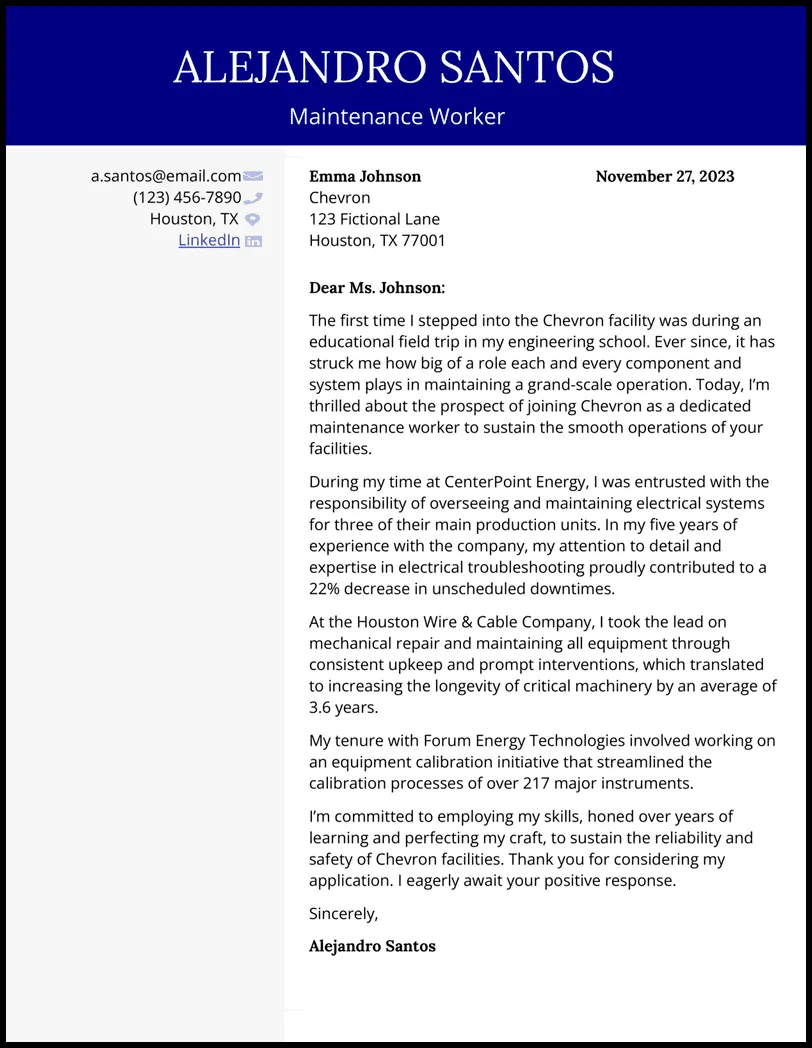
The tone of your cover letter should be professional, enthusiastic, and tailored to the specific job and company. Show your interest in the position and the company. Use a positive and confident tone. Avoid being overly casual or informal. Reflect the culture of the company. If the company culture is more relaxed, you can use a slightly more conversational tone, but always maintain professionalism. Make sure your tone is appropriate for the specific industry and job. Be sincere and authentic. Your genuine enthusiasm for the role and company will make a positive impression. The tone of your letter should match the personality of the company. Always be sure you are showing off your professionalism in your letter. When in doubt, always choose a professional tone.
Closing the Letter
The closing of your cover letter is your final opportunity to make a strong impression. It should express your enthusiasm for the position, summarize your key qualifications, and include a clear call to action. End your letter with a professional closing, such as “Sincerely” or “Best regards.” This confirms your professionalism and respect. A strong closing can significantly increase your chances of being invited for an interview. By ending on a positive note, you leave the employer with a lasting impression of your capabilities and enthusiasm. Your closing statement is another chance to make sure your professionalism shines through.
Expressing Enthusiasm
Express your enthusiasm for the opportunity in your closing paragraph. State your genuine interest in the position and the company. Mention something specific that excites you about the role or the company. This will show that you’ve researched the company and are genuinely interested in working there. Demonstrate your passion for the maintenance field and your desire to contribute to the company’s success. This enthusiasm will help you stand out from other applicants. Expressing your enthusiasm makes your cover letter more engaging. It also makes you seem like a better employee. Highlighting your excitement will help the recruiter see you are the right fit for the company.
Call to Action
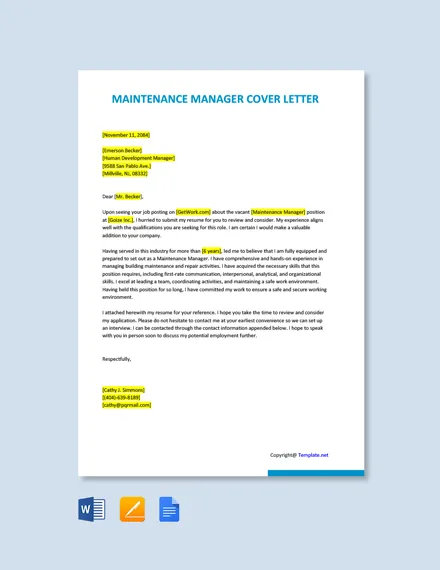
Include a clear call to action at the end of your cover letter. Request an interview. Make it easy for the employer to contact you. Include your contact information again, just in case they missed it earlier. Thank the hiring manager for their time and consideration. A clear call to action makes it easy for the hiring manager to move forward. It shows that you are proactive and eager to take the next step in the hiring process. Make sure to thank the employer for their time. Expressing gratitude will help make a good impression. This action shows the recruiter that you are ready to get hired and that you are interested.
Proofreading and Editing
Proofreading and editing are essential steps in writing a successful maintenance cover letter. Errors in grammar, spelling, or formatting can make you appear unprofessional and may lead the hiring manager to overlook your qualifications. Always proofread your cover letter multiple times. Use a grammar and spell-checker to catch any obvious errors. Read your letter aloud to catch any awkward phrasing or grammatical mistakes. Have someone else review your cover letter. A fresh pair of eyes can often catch errors that you may have missed. Correcting errors and making sure everything is perfect can make the difference between getting the job and getting rejected. Always take the time to edit and proofread your letter to make sure it is correct. Correcting the errors in your letter will show you are a professional who pays attention to detail.
Common Mistakes to Avoid
Avoid common mistakes that can hurt your chances of getting hired. Don’t use generic or boilerplate cover letters. Tailor each letter to the specific job and company. Avoid typos and grammatical errors. Always proofread carefully. Don’t repeat information from your resume. The cover letter should provide additional context and highlight specific skills. Don’t be too long. Keep it concise and to the point, aiming for one page. Avoiding these mistakes can significantly improve your cover letter. Make sure you present yourself as a professional who knows what they are doing. Doing this will make a great first impression.
Grammar and Spelling
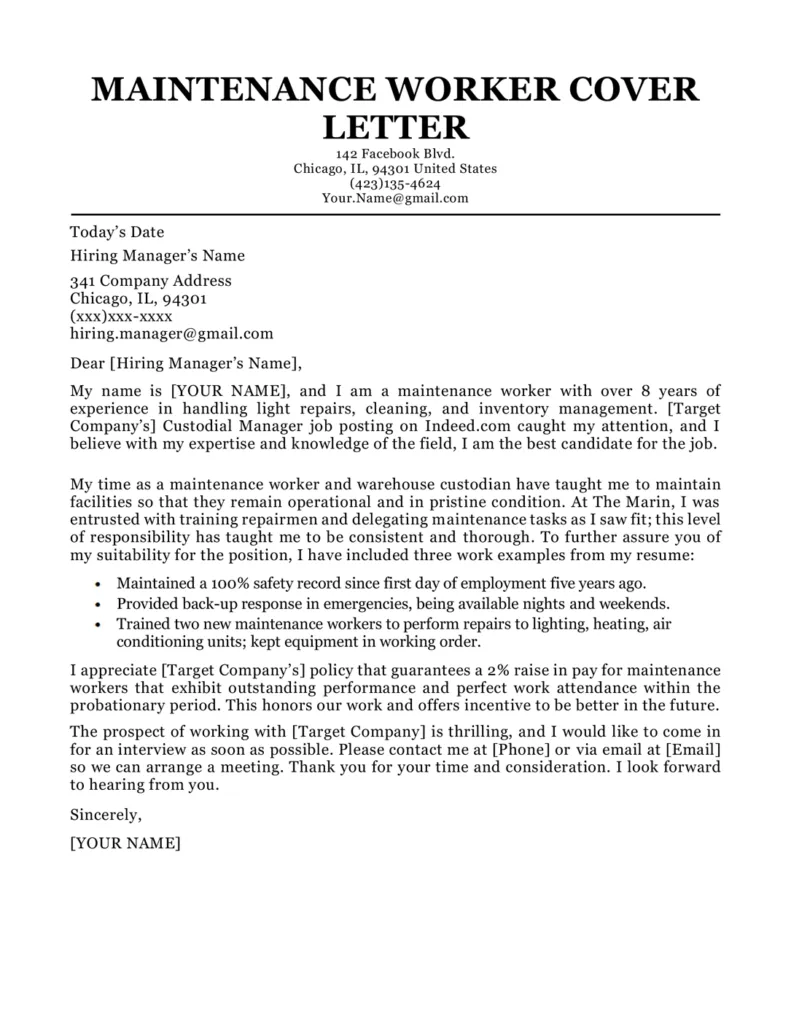
Poor grammar and spelling can create a negative impression. Always proofread your cover letter for any errors. Use a grammar and spell-checker to catch any mistakes. Make sure your sentences are clear and concise. Avoid using slang or jargon that the hiring manager may not understand. Double-check the names of the hiring manager and the company. A simple spelling error can make you look unprofessional. Use tools like Grammarly or ProWritingAid to check your work. Your goal should be to present yourself as a professional candidate. Spelling and grammar errors can make you appear unprepared for a professional setting, potentially leading to your application being discarded. A mistake-free letter demonstrates your attention to detail.
Length of the Letter
Keep your cover letter concise and to the point. Aim for a one-page letter. Hiring managers are busy and may not have the time to read a long cover letter. Focus on your most relevant skills and experience. Use clear and concise language. Break up the text with headings and bullet points to make it easier to read. A well-written, concise cover letter shows that you respect the hiring manager’s time. Brevity is key, so make your points quickly and clearly. Always choose quality over quantity in order to make sure you get hired.
Examples of Successful Maintenance Cover Letters
Review examples of successful maintenance cover letters to get ideas and inspiration. Use these examples as a guide, but always customize your cover letter to reflect your own skills and experience. Pay attention to how the examples highlight relevant skills, quantify achievements, and tailor the letter to the job requirements. Analyze the formatting, tone, and structure of the examples. Make sure to tailor your examples to fit the needs of the company.
Maintenance Technician Example
When crafting a cover letter for a Maintenance Technician role, highlight your technical skills and ability to troubleshoot and repair equipment. Mention your experience with specific tools and systems. Include examples of how you have maintained and repaired equipment. Use specific examples, such as, “Reduced equipment downtime by 20% by implementing a new preventative maintenance schedule.” Show your problem-solving skills and your ability to work independently. Demonstrate your ability to follow safety protocols. Focus on relevant experience and your ability to maintain and fix equipment efficiently.
Maintenance Supervisor Example
A cover letter for a Maintenance Supervisor should emphasize leadership, management, and organizational skills. Highlight your experience in supervising a team of maintenance technicians. Include examples of how you have improved team performance and increased efficiency. Mention your experience with budgeting, scheduling, and project management. Include examples of your ability to develop and implement maintenance strategies. Demonstrate your ability to communicate effectively and work with other departments. Focus on the leadership aspect of the job and how you have enhanced the company as a whole. Show how you will be a great leader for the company.
Frequently Asked Questions (FAQ)
Here are some frequently asked questions about writing a maintenance cover letter. Getting answers to the questions will help you in writing your cover letter. Make sure your questions get answered so you can make the best cover letter possible.
How Long Should a Maintenance Cover Letter Be?
Your maintenance cover letter should ideally be one page long. It is important to be concise and to the point. Focus on the most relevant skills and experience. Use clear and concise language to communicate your qualifications effectively. Length is key, so make sure you highlight the most relevant information.
What Skills Should I Highlight?
Highlight the skills that are most relevant to the specific job. Common skills to include are troubleshooting, repairing, and maintaining equipment. Also, show your knowledge of electrical, plumbing, and mechanical systems. Tailor your skill to match the job description. Emphasize skills like problem-solving, teamwork, and communication. Show the recruiter that you are a well-rounded candidate with the right skills and experience.
How Can I Tailor My Letter to Each Job?
Carefully review the job description and identify the key requirements and skills. Customize your cover letter to emphasize those requirements. Use keywords and phrases from the job description. Give specific examples from your experience that show you have the skills and experience that the employer is seeking. The more you customize your cover letter, the better. If you are genuinely interested in a job, make sure you are willing to customize your letter to better suit their needs.
